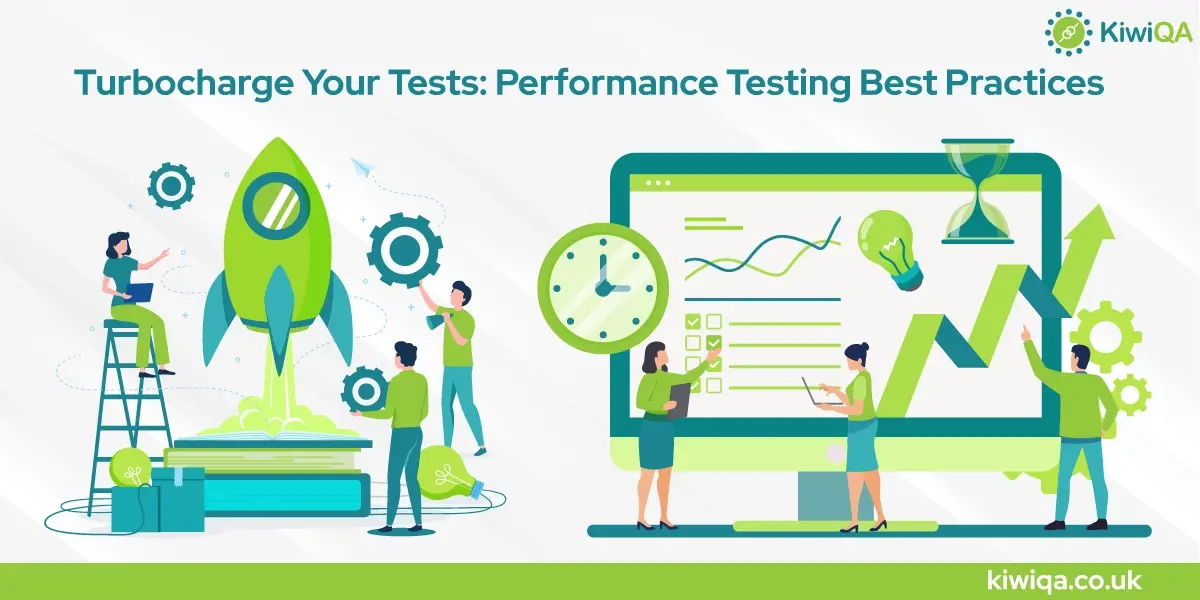Performance testing is a type of testing that checks how well a computer system or software application performs under different conditions. It evaluates the speed, responsiveness, stability, and overall efficiency of the system, making sure it meets the performance requirements.
Imagine you have a car, and you want to see how fast it can go, how smoothly it runs, and if it stays reliable during a long journey. Performance testing for software or systems is quite similar. It assesses how quickly a website loads, how many users it can handle simultaneously, and if it remains stable under heavy usage. There are various types of performance testing.
Load testing best practices examine the system’s performance under normal and peak loads, simulating the number of users it can handle. Stress testing goes beyond the normal capacity to check how the system behaves under extreme conditions. Other types include endurance testing, which evaluates performance over an extended period, and spike testing, which assesses the system’s response to sudden increases in load.
The goal of agile performance testing best practices is to ensure that the software or system operates efficiently and reliably, providing a smooth experience for users without slowdowns or crashes, much like making sure your car runs smoothly on the road.
Performance testing is crucial for mobile and desktop apps as it assesses the high speed, performance, and efficiency of software, ensuring they meet performance requirements. By simulating various conditions, such as extreme usage scenarios, performance testing identifies potential bottlenecks and risks in an app framework. This proactive approach helps businesses address performance issues before software is deployed. Ultimately, Software performance testing best practices are vital for delivering high-quality and efficient software that meets user expectations.
In this article, you will learn about the best practices in performance testing and how to improve the overall performance of a test case and app. This is not one of the many performance testing best practices blogs; it is a detailed blog about the practices that help you achieve the best performance testing results needed.
Also Read: The Future of Scriptless Automation Testing in Selenium
It is important to outline the goals of performance testing before the final testing round. Once the goals are set, the application performance testing best practices can be adopted, and the testing can start.
Importance of Performance Testing
Many parameters of app performance need to be tested in a test environment. The parameters like responsiveness, scalability, and stress are tested through different test scenarios. There are performance tests that focus on checking for average response time, load bearing, and other aspects of the app. The resource utilization pace and the concurrent output pace are also looked at by performance testing services. Now, let us dive into performance testing best practices to ensure that our testing processes go on very smoothly.
What Are the Best Practices for Performance Testing?
The best practices in performance testing help tackle many challenges in performance testing. The cloud performance testing best practices and other forms of requirements ensure that the app is tested properly and the standards are maintained.
1. Understanding Performance Testing Definitions
The definition of performance testing is not limited to the testing of scalability or responsiveness. It touches upon all the aspects of a software or system that contribute to its functions and performance.
2. Planning and Preparation
The planning and preparation phase of the performance tests also matters a lot in determining the success of the final tests. These are the practices that you should use when preparing for the performance tests.
- Setting Clear Objectives
It is very important to define the scope of the performance tests when you start. The definition of the objectives and scope of the performance tests ensures that all the parameters of the app are tested properly. The tests should be designed according to the app testing objectives and the use cases.
Before the performance tests are done, you should at least define the performance criteria on which the application is supposed to be tested. The performance tests are designed according to the criteria outlined by the testing team. The criteria for performance testing include throughput, responsiveness, speed, scalability, and resource utilization. All the performance criteria need to be defined and applied to the test cases for the performance test to be successful.
- Understanding the Test Environment
The performance test that the testing team designs should outline the real-life scenarios that the app will face later on. The test environment should take into account the real-life insights and use cases gathered from user groups. The performance tests should be designed to test out all the aspects of the app based on the user group and real-life cases of problems that it aims to solve.
3. Test Design and Development
- Creating Effective Test Cases
User scenarios are important in designing the test cases for performance testing because, at the end of the day, it is the users who will be using the app. Therefore, it is important to look at all the user group insights, consider user feedback, and choose the relevant test cases. Every app is designed to solve a particular problem in real life. When we consider real-life problem scenarios, the test cases are effective in flagging the relevant performance issues.
One of the best ways to practice effective performance testing is to gather user insights and design diverse use case scenarios and test scenarios for the testing process. When the code is tested in diverse use case scenarios, the final product will be ready to tackle any kind of performance request and issue in the future. The unpredictability of the app code reduces, and the performance of the app becomes more consistent.
- Scripting and Automation
Test scripting is a crucial process that hugely supports the testing process. Earlier, professionals used to script new tests manually. This used to take a lot of time and effort from the side of the professionals. However, test scripting nowadays is done through automated testing tools. These testing tools get the job done in faster timelines.
Tools like Selenium, Appium, Junit, and Cucumber are very versatile and perfect for performance test scripting. The choice of test scripting tool depends on factors such as the type of application, programming language, testing requirements, and the skill set of the testing team.
Performance test automation brings efficiency and precision to the testing process by automating the simulation of user interactions, load scenarios, and stress conditions. This ensures consistent and reliable results, accelerates testing cycles, identifies performance bottlenecks early, and allows for scalability testing, ultimately enhancing the overall performance and reliability of software applications. The performance tests get done quickly and accurately when automation tools are used. Testing automation tools not only work for scripting the tests but also help with the execution of the performance tests.
4. Execution and Monitoring
- Running the Tests
Sequential execution strategy in performance testing involves executing test scenarios one after another, focusing on a linear and step-by-step approach. This method helps identify and address performance issues systematically, ensuring that each test scenario is executed individually before moving on to the next.
Parallel execution strategies in performance testing involve running multiple test scenarios simultaneously, enabling efficient evaluation of system performance under various conditions. This approach accelerates testing cycles, identifies bottlenecks quicker, and provides a comprehensive assessment of an application’s scalability and responsiveness by simulating concurrent user interactions.
The scheduling of long-duration tests should be done in such a way that the tests can run for a long time without any interruption. The completion of the testing cycle is important for the success of the performance tests.
- Monitoring and Data Collection
For the success of the performance tests, you also need to use real-time monitoring strategies. It is important to create monitoring mechanisms that keep an eye on the performance tests and flag any issue immediately. Many integrated performance testing tools have built-in real-time monitoring features that help create the final testing environment. With real-time monitoring strategies, the team can automate the monitoring process and also ensure that there are no issues in the testing cycle.
After all the testing is done and performance tests are successful, it is also important to collect comprehensive performance data and ensure that the data can be used to improve the performance testing cycles. The performance testing cycles need to be data-driven and improved constantly for the best results. The dashboards and assisting tools can be integrated to gather insights from the performance testing cycles.
Also Read: Cloud-Based Selenium Testing: Benefits and Implementation
5. Analysis and Optimization
- Interpreting Test Results
Once the performance tests are done completely and the results are out, you need to analyze the data and insights to understand the bottlenecks and the latent issues in the app framework. The latent issues and bottlenecks are flagged so that they can be resolved and mitigated with the help of developers and testers. The development team looks at the performance test reports and reworks on the bottlenecks to create an even better application and processes inside the application.
The baseline and the threshold values of the performance tests need to be understood to see which are the baseline of the parameters and beyond what threshold the application does not work properly. The thresholds and baselines need to be maintained after the launch of the app. The baseline and thresholds can also be scaled up according to the demands of the user groups.
- Performance Tuning
Once the performance level and parameters are clear for the application, it is the responsibility of the performance testing team to check for the performance levels and optimize them. There are many performance optimization techniques that the development team applies to increase the performance level of the app in the MVP.
The development team optimizes the code to make the app performance better. The code is reviewed by the testing and development team completely to ensure that the code is efficient and accurate. Minor code errors and bugs that were present were removed from the app code base.
The development team also continues to work on the back end and optimizes the database queries and other factors to ensure that the app performance is improved more than before. The development team might also practice caching and content delivery networks to ensure that the app works properly in differing scenarios.
The development and testing team then gets together to test the code base, and the app features again and again to check for further issues and bugs. The bugs and issues are flagged again, triggering a cycle of continuous improvement. The continuous improvement and continuous testing cycles ensure that the app product shows the highest performance ever possible. The development and testing team collaborates on the CI/CD pipeline for the same.
6. Reporting and Documentation
- Effective Reporting Techniques
Whether you are running an outsourcing app development and testing company or you are trying to create an app in-house, the reports of testing should be simple and understandable so that all the stakeholders involved in the process understand the process and results of testing.
When the reporting mechanism is effective, and the reports are understandable and insight-driven, the team learns effectively from the testing process and also goes forward to create better test scenarios. The testing reports can also improve the overall development process to reduce the issues that arise in the final product.
Instead of making the reports data-heavy and full of development and application jargon, it is better to adopt visual representations of data to represent bulk data on the same page. For example, response time graphs, throughput charts, and error rate graphs should be included in the performance test reports to make the picture clear for your team and clients.
- Maintaining Documentation
Documenting test processes and results is crucial for traceability, transparency, and knowledge sharing in software development. It provides a comprehensive record of testing activities and enables efficient issue resolution. The documentation serves as a valuable resource for future reference and continuous improvement in the development lifecycle.
Some good practices for record-keeping should be adapted to maintain the app’s performance records. The testing team should keep a detailed log of the issues traced and how they were resolved. The team should also use version control systems for record keeping of all the improvements made. A centralized documentation system for the testing and development team is also helpful in proper documentation and record keeping.
7. Advanced Topics and Trends
- Integrating with DevOps and Continuous Integration
The use of performance testing and iterative tests supports the continuous improvement and integration channels of a testing and development company. The testing process should be integrated with the DevOps so that developers can gather insights from the continuous integration channels. The communication between the DevOps officials and the testers should be transparent. These are the best practices for performance testing on DevOps.
- Emerging Technologies and Tools
Today, many new tools and technologies are coming out for performance testing. These tools and techniques are continuously improving the entire performance testing process. These tools are automated and effective in reducing the time to test and deploy. The testers and developers need to stay ahead of the trends and continue to upskill to work in the performance testing arena.
Ready to Boost Performance Testing? Let’s Get Started!
If you are now familiar with the performance testing matrices needed for your company, you are ready to boost app development and testing. Many robust, automated tools are ready to improve performance testing for your company. Not only performance testing but also other areas of testing need to be improved for the testing process to be successful.
The success of the testing process depends entirely on the skills and mindset of the company and its development team. The development team should keep the mindset of continuous improvement and continuous delivery so that performance testing is done quickly and effectively.
If you are ready to take your software performance testing company to a new height, you need to hire people who are ready to learn new things and new skills. The workforce needs to adapt to the evolution of performance testing tools and practices. The practices should be reviewed from time to time to ensure that the software testing process is a success in the future.










